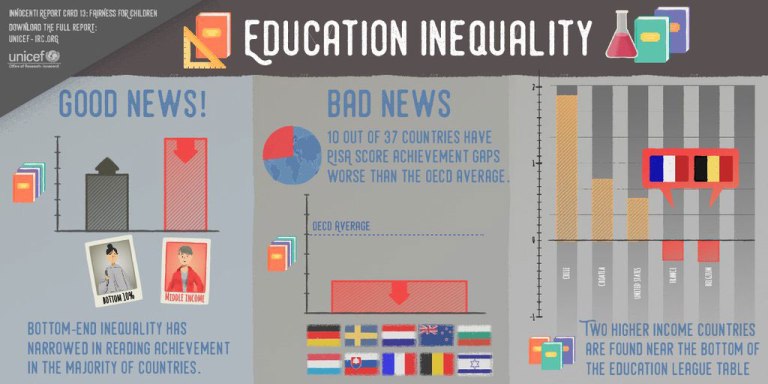
UNICEF office of Research (2016). ‘Fairness for Children: A league table of inequality in child well-being in rich countries’, Innocenti Report Card 13, UNICEF Office of Research – Innocenti, Florence.
The term ‘digital divide’ is used in contemporary media sound-bites to describe any form of inequality in the online community, however; in scholarly circles ‘digital divide’ is a complex phenomenon that is concerned with the impact of information inequality due to lack of access to information and communication technology with three distinct aspects: global divide, social divide and democratic divide (Norris, 2001). The gap between the information-rich and the information-poor is generally regarded as the main defining measure of digital divide, where increasing ease of access to New Media is regarded as a partial solution to democratization and development challenges around the globe (Moyo, 2009).
However, Moyo (2009) also argues that defining digital divide in terms of access to information technology like computers or smartphones undermines the far reaching implications of the problem, and impedes the search for potential solutions in policy making. The NY Times article titled ‘An Online Education Breakthrough? A Master’s Degree for a Mere $7,000′, describes how reputable institutions of higher learning are increasingly adopting online teaching procedures (Carey, 2016). A quote from the article describes how online learning is helping a demographic who would not otherwise be able to pursue higher education, “The traditional on-campus students in the Georgia Tech master’s program tend be young and just out college, with an average age of 24. The average age of the online students was 35. A sizable number were 45, 50 and older. Ninety percent were currently employed.” (Carey, 2016).
As quoted by Moyo (2009, p.123), “While physical access to the computers and the Internet is certainly one of the key variables for defining the digital divide, there is a need to broaden the concept by looking at how other factors such as literacy, technological literacy, content, language, network and the costs that are associated with Internet access, help in the understanding of the digital divide.”
So even though online delivery of university degrees from reputable institutions is ‘low-cost’ and easily accessible, it does not make any substantial reductions in digital divide in terms of global education, because for most third world country citizens $7000 is a lot of money and more than enough to earn a master’s degree from an offline physical institution, with face-to-face offline interactions with classmates and teachers. And despite access to internet, many may not be able to benefit from this online learning opportunity because they may not speak English, or may not have technological literacy. However there are better examples of how e-learning technologies can reduce global inequalities in education, with free, easy and open source tutorials and learning interfaces provided by Khan Academy, which is available in 26 languages including Bahasa Melayu, Bengali, and Telugu. So even a low-income village girl from Malaysia, India or Bangladesh who could never afford decent English language education can learn various subjects in her own language as long as she has access to internet (Khan Academy Help Center, 2016).
Simple online access to university degrees is not enough to reduce global inequalities in education by a significant amount. Tuition fees, technological literacy, costs associated with access to high-speed internet, and language barriers also need to be kept in consideration if online university degrees are to have a substantial impact in reducing global inequalities in education.
References:
Carey, K. (2016). An Online Education Breakthrough? A Master’s Degree for a Mere $7,000. The New York Times. [online] Available at: http://www.nytimes.com/2016/09/29/upshot/an-online-education-breakthrough-a-masters-degree-for-a-mere-7000.html?_r=0 [Accessed 11 Oct. 2016].
Khan Academy Help Center. (2016). Is Khan Academy available in other languages?. [online] Available at: https://khanacademy.zendesk.com/hc/en-us/articles/202483750-Is-Khan-Academy-available-in-other-languages- [Accessed 11 Oct. 2016].
Moyo, L., 2009. The digital divide: Scarcity, inequality and conflict. In: Creeber, G. and Martin, R. Digital cultures: Understanding new media. Maidenhead, U.K.: Open University Press, McGraw-Hill, pp.122-129.
Norris, P., 2001. Digital divide: Civic engagement, information poverty, and the Internet worldwide. Cambridge, USA: Cambridge University Press.